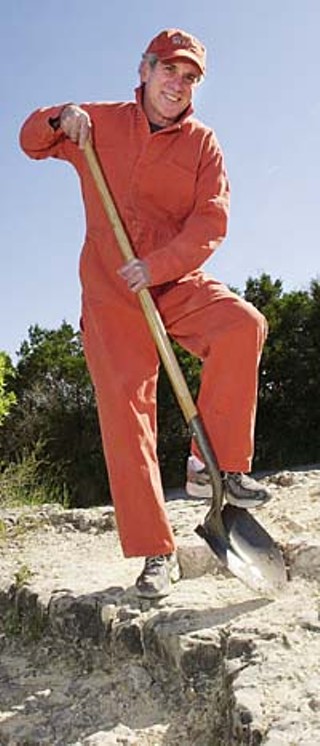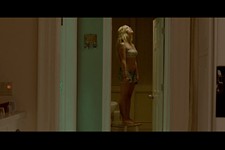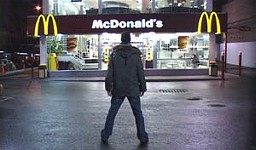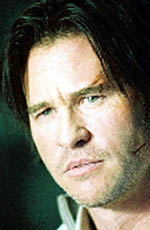Dig Deeper
Celebrated Austin author Louis Sachar brings his wacky, wickedly funny children's book 'Holes' to the big screen
By Peter Debruge, Fri., April 18, 2003

There's something the folks at Disney don't want you to know about their new kids' movie: namely, what it's about. What they do want you to know about Holes is that it features a motley band of Goonies-like boys, that it's based on the award-winning children's book by Austin's own Louis Sachar, and that it's far and away the best live-action kids' movie the studio has released in years. But as for the story itself ... well, that's a bigger secret than what lies stashed at Camp Green Lake. (The story's fictional Camp Green Lake, as anyone who has read the book can tell you, is the correctional facility where our wrongfully imprisoned young hero, Stanley Yelnats, is forced to dig a 5-foot-by-5-foot hole every day in search of buried treasure.)
Now what kind of mother would take her kids to see a movie about juvenile delinquents serving time in a hard-labor prison camp? You can't blame Disney for being a little nervous about how to position the film. It's a tricky proposition, on which marketing representatives for the studio declined to comment. If they're not careful, they risk making a movie that's every bit as magical as The Wizard of Oz look like a just-for-kids episode of the like-named HBO prison drama. But while the film's scenario may not go over well with test-group mommies, it scores off the charts with kids.
"Kids are fascinated with the idea of a kid being sent to prison, wondering what it would be like to go to such a place," says Sachar (pronounced "Sacker"), whose tale of cruel and unusual punishment won both the National Book Award for Young People's Literature and the prestigious Newbery Medal. "I sometimes think that people just underestimate kids. If they write adult books, they try real hard to do everything that they should do with literature, but in children's books, people think, 'Oh, it's kids. We can treat them like little babies.' I never do that. When I'm writing, I'm obviously aware that I'm writing for kids, but at the same time, I'm writing something that I would like to read. I may tone down the language, write in shorter sentences so that it's easier to read. As long as it's not too depressing and as long as there's hope and wit to it, I think [a little mild torture] is part of the fun."
How else would you explain the satisfaction readers feel when Cinderella triumphs over her evil stepsisters or the thrill they get when Harry Potter vacates his cupboard under the stairs for a place at Hogwarts? Just look at Lemony Snicket's popular A Series of Unfortunate Events books, which wholeheartedly embrace the notion that the grimmer the fairy tale, the more satisfying the experience (those books, set to star Jim Carrey as the treacherous Count Olaf, may have encountered their own unfortunate delays, but it's only a matter of time before they, too, are coming soon to a theatre near you). Children are simply fascinated by stories of discipline and mortality, determining their own boundaries and values against such models. Hence the appeal of Holes, with its outwardly forbidding scenario and its infinitely imaginative resolution. But it wasn't even the kid-in-prison angle that inspired Sachar in the first place.
"More than anything, it was just my depression over the heat of Texas summers," Sachar sighs (these are not the words of a boy who grew up in Texas, but rather those of a northerner, born in New York, who moved to Austin late in life). "I remember we had gone away for the summer, went to Maine. We came back ready for school to start, and it was still oppressively hot. I just started writing about the heat and came up with Camp Green Lake."
"There is no lake at Camp Green Lake." So begins Sachar's novel. "Now it is just a dry, flat wasteland." The movie, also written by Sachar, opens with a boy named "Barfbag" sweating beneath the blistering West Texas sun. Barfbag is supposed to be digging a 5-foot-by-5-foot hole, but the heat is more than he can stand. Instead, he removes his ratty old tennis shoe and offers his bare foot to a waiting rattlesnake. A snakebite, at least, will earn him a few days in the shade.
Incidentally, it's a pair of ratty old tennis shoes that lands Stanley Yelnats in this predicament in the first place. Falling from the sky, the wayward shoes land directly on Stanley Yelnats' head. As luck would have it, they belong to one Clyde "Sweet Feet" Livingston, a celebrated sports star, and the mere accusation that Stanley stole them is enough to earn the boy a stay at Camp Green Lake.
"The book began with the location, which I'd never done before," Sachar says. "I always start with characters." Sachar's best-known location, and the one that got him started writing children's books, is the notoriously wacky Wayside School, where crazy kids and silly teachers attend classes in a 30-story school built on its side. Starting with the book Sideways Stories from Wayside School, Sachar went on to write nearly 100 stories about the school, published in three bestselling collections.
"I guess in high school I was interested in writing, but it never even entered my consciousness that I would write children's books," Sachar says. "I was reading Dostoyevsky and Kurt Vonnegut. They were my heroes. And then, my senior year of college at Berkeley, just for an easy credit, I signed up to be a teacher's aide at a nearby elementary school. It was a pass/fail class, and all I had to do was help out in the classroom. I did it because there was no homework and no tests, but then it turned out that I loved it. I just had a great time with these bright-eyed kids and thought I'd try writing a children's book. I would picture the different kids I knew from that school in my mind and make up a short story about them."
Though millions of children have since read the book, its first printing sold fewer than 10,000 copies. But Sachar's early followers were a fervent bunch. "For some reason, I started getting all these fan letters from Texas." Most of the fan mail Sachar received was pretty predictable. Kids wrote to tell him they'd read the book, offering their thoughts on their favorite part, their favorite color, or whatever. "But then there was this group of fifth-grade girls who all wrote to me saying things like their single teacher thinks I'm cute, and she's really pretty, and she's always available, all this stuff about their teacher. I figured I'd never actually go there, so I wrote them back saying, 'Well, your teacher sounds really hot.'"

But Sachar did go there. On his next trip to Texas, he made a detour through Plano to pay a visit to the school. Though he didn't exactly fall for the girls' teacher, he did hit it off with the school counselor, Carla Askew. She inspired him to write his next novel, There's a Boy in the Girls' Bathroom, in which a new counselor named Carla helps reform a loveable misfit. Sachar succeeded in wooing Askew away from Texas -- they were married in San Francisco in 1985 -- but fate would eventually draw them back. When the book won a Texas Bluebonnet Award in 1990, Sachar returned to accept the prize and decided to move to Austin for good. It was in Austin that Sachar wrote Holes, squirreled away in a private office where only his dogs Tippy and Lucky are allowed to trespass. ("I never talk about anything until it is finished," he says. "Not even my wife or daughter know what I'm currently writing.") And it was in that office where Sachar sat down to adapt his novel for the screen.
It's one thing to grant a children's book author veto power as his book is being made into a movie -- Sachar's contract allowed him to reject any screenwriter he felt wasn't up to the task -- but the idea of allowing such a writer to adapt his own novel is all but unheard of in Hollywood. Typically, the first step after optioning the rights to a hit kiddie-lit property is to assign a top-dollar industry screenwriter who can wrestle the material into something suitable for the screen. With the Harry Potter series, for instance, author J.K. Rowling may be the one to blame for insisting that the films so slavishly adhere to her books, but it was Oscar-nominated screenwriter Steven Kloves who actually handled the adaptation.
In the case of Holes, director Andrew Davis had personally selected the book as something he wanted to direct, the kind of project that might help him prove he was capable of making more than just action movies like The Fugitive and Collateral Damage. Davis loved the material and insisted that Sachar try to adapt it himself. "I just felt very comfortable as a filmmaker and having written scripts myself that I could guide Louis and take what he had and turn it into a movie," Davis says. "I was very concerned that somebody would come along and not appreciate and respect the nuances of the characters and the relationships to each other and the fabric of the movie and have to have the man who created this wonderful piece of material be disappointed."
Holes was not the first of Sachar's books to be optioned for the screen, although it was certainly the first time anyone had approached him about writing a movie himself. In the days before he found an agent, "some Hollywood sleazeball" had managed to get the rights to the Wayside School stories (he has since won them back, and they are currently in development as a possible animated television series). There's a Boy in the Girls' Bathroom had also been optioned to become a television movie, but nothing ever came of it. Still, Sachar didn't know the first thing about screenwriting, other than that it was the process by which some of his favorite novels had been destroyed.
"Until Andy started sending me all these scripts by other screenwriters, I'd never even seen a script before," Sachar says. "My first reaction was, 'No! I'm really excited that my book's being made into a movie. I'd like to get someone who knows what they're doing.' He said, 'Well, write the first draft. We can always get someone to rewrite it if necessary. That way your name will always be part of it.'" Sachar reluctantly agreed, though he encouraged Davis to go ahead and ask a professional to work on it (Crazy in Alabama's Mark Childress, who had adapted his own novel, seemed most promising). But the instant that Sachar started writing, he got caught up in the process. "It seemed to be going really well, so I actually called him up one day and told him, 'Hold off on trying to get someone else. I'm really enjoying this process.'"
Once Sachar finished his draft, he met with Davis again to review the material. According to Sachar, the most difficult part of writing both the novel and the screenplay was weaving together multiple storylines -- the novel tells the stories of four generations, with all of Stanley's troubles tracing back to a curse on his "no-good-dirty-rotten-pig-stealing-great-great-grandfather" -- and figuring out how all the pieces should come together. In the meeting, the director broke down the entire novel into more than 100 scenes, writing each on a separate 3-by-5 card, then pinning them all on a big bulletin board. Then the process of cutting, expanding, and rearranging began. "He went through and said, 'Now as you rewrite it, this card should take half a minute, this one should take three minutes, this one should take one minute, and so on.'"
Though the campers don't realize it, while carrying out their "character building" task of digging fresh 5-foot-by-5-foot holes, they are actually helping the Warden search for buried treasure hidden by the notorious outlaw, Kissin' Kate Barlow. In the book, Sachar clustered Kissin' Kate Barlow's background into one section. For the movie, her story has been more evenly distributed throughout Stanley's adventure, making for a more satisfying subplot.
One of the most significant changes came not in writing, but in casting. No doubt fans of the book will be pleased by the selections of Sigourney Weaver and Jon Voight, who are both particularly inspired matches for their characters, the Warden, who paints her fingernails with rattlesnake venom, and her sunflower-seed-chewing "boss man," Mr. Sir. However, the choice of gangly Even Stevens star Shia LaBeouf to play young Stanley Yelnats might take a little getting used to. The novel describes Stanley as a lumbering fat kid who eventually earns the nickname "Caveman." Over the course of Stanley's stay at Camp Green Lake, he makes friends and loses weight. Whether deserved or not, his stint in the juvenile-detention facility actually turns out to be a positive, life-changing experience for the boy (and perhaps the best justification for a premise that parents might otherwise find objectionable).
According to Davis, it would have been virtually impossible to find a child actor who could portray Stanley's weight loss. "We chose the best actor we could find who seemed to have a kind of kooky quality to him," he says. "I always thought of a young Dustin Hoffman/Gene Wilder/Tom Hanks-type kid to play this part, someone who had a real quirkiness to him, and that's who Shia is." And lucky for Davis, Shia LaBeouf also happens to be a fast-rising star -- he's set to appear in both the Charlie's Angels sequel and the Dumb and Dumber prequel later this summer.
But no matter how perfect the cast, the success of Holes ultimately depends on finding the right location. For the sake of the book, Sachar had the luxury of inventing the perfect scorching-hot spot to torment his unhappy campers, but when it came to shooting the movie, location scouts would have to find a real place to set up camp. Needless to say, it's not easy trying to find an extinct West Texas lakebed that looks like it's been dry for 100 years, especially one you can magically make wet again when flashing back to better days at the godforsaken place.
"We couldn't find a location in Texas that was close enough to hotels where we could get the crew back and forth every day," Davis says. "We'd have to drive four hours to get to our location, and it didn't make sense because the kids are on the clock when they're traveling." The production crew eventually settled on Cuttleback Dry Lake Bed, near Ridgecrest, Calif., which matched up nicely with Lake Casitas, outside Santa Barbara. Both locations are surrounded by the same range of mountains, which meant that Davis could easily dissolve from one shot to another, making it look as if the lake had just filled up with water. "It was difficult shooting there. It was very hot and windy, and we were surrounded by people prepared to go to war in Afghanistan. There were planes flying over and munitions going off around us."
No matter what anyone tells you, digging holes while working on a major Hollywood movie is no more fun for the crew than it would be for the kids at Camp Green Lake. "We dug 400 holes and made it look like 10,000 in a couple of places," Davis says. "Actually, I was really pissed off at Louis Sachar when we first started. I said, 'Louis, have you ever dug a 5-foot hole?' and he said, 'No.' Well, you can't! You can't dig a 5-foot hole with a 5-foot shovel. There's nowhere to swing it!" By the end of production, everyone involved had become intimately familiar with exactly the kind of torture the Camp Green Lake prisoners put up with every day. And as we know, the threat of torture makes for the best children's stories -- whether or not Disney is ready to embrace that idea in its advertising. But rest assured, the studio wouldn't be distributing the picture if it didn't believe in the content. If anything, Disney's involvement is the seal of approval parents need, letting them know that the movie is, in fact, the instant classic that Sachar's novel suggested it could be.
"The old fairy tales were scary as hell, and Disney made a living on that," Davis laughs. "There are a lot of really heavy dark kids' movies, and this thing has some very poignant themes in it. Ultimately it's really about working it out and warmth and caring. It's wonderful that Disney is handling a movie this hip. I think it's good for them, and it's going to bring this movie into homes and families that are going to have something to talk about when it's over." ![]()
Holes opens in theatres on Friday. See Film Listings for review.










